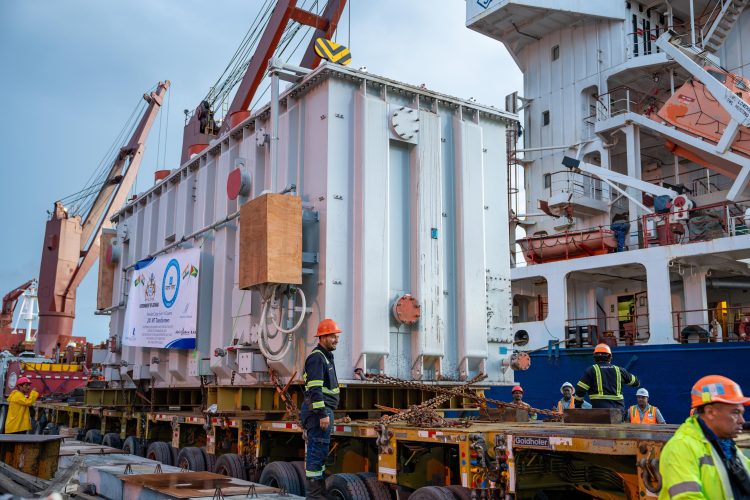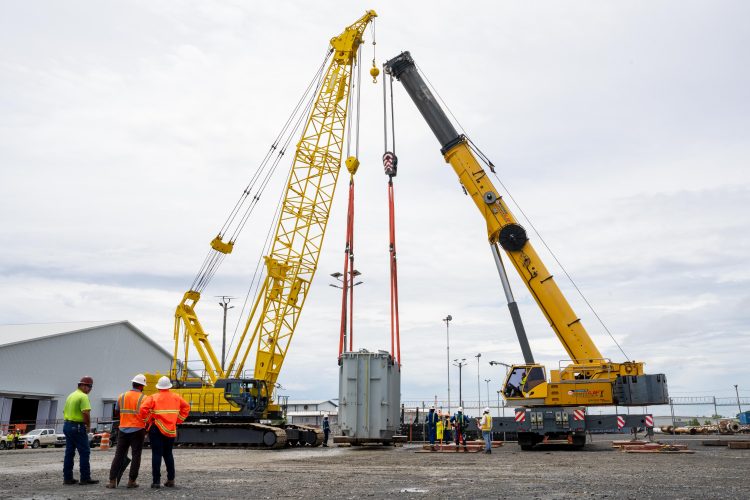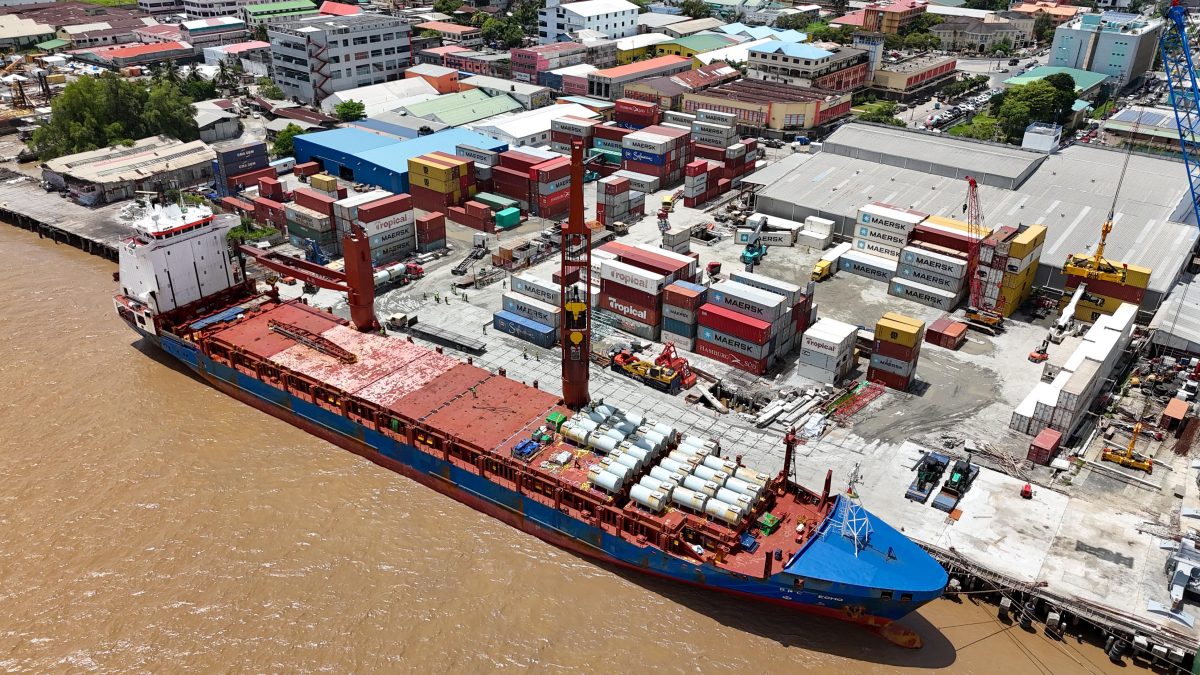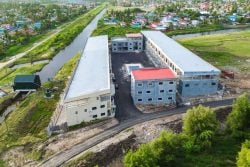-said to be heaviest cargo ever handled in Guyana’s history
The BBC Echo Vessel last week successfully berthed at the Muneshwers Shipping, John Fernandes and Guyana Shore Base Inc (GYSBI) terminals offloading transformers for Guyana’s gas-to-energy and the Guyana Power and Light (GPL) enhancement projects.
Among the 16 transformers delivered were two units, each weighing an unprecedented 241 metric tons—the heaviest cargo ever managed in Guyana, according to GYSBI.
Cranes Guyana Inc (CGI), a subsidiary of Muneshwers Limited and John Fernandes Limited (JFL), was awarded the contract by Boltcargo India to undertake the discharge, side-wharfage, transportation, and storage of nine transformers. Of this number, Muneshwers Limited facilitated the side-wharfage for the offloading of six transformers and miscellaneous cargo, while JFL was responsible for the discharge of three including the two 241-metric ton transformers, which were then transported by Daco Heavy Lift to JFL’s Inland Terminal for storage. The release said that Paragon Transport and Lifting Services alongside Sammy Multilift Services Guyana Inc. and RSD Cargo Transit Inc. handled the transportation of seven transformers and 244 accessories.


“The complexity of this historic arrival was underscored by the 12 hours it took to safely transport one 241 metric ton transformer from Water Street to the JFL Inland Terminal on Mandela Avenue. The entire operation spanned five days and required over 3,300 man-hours, not including additional support from GPL, GTT, and the Guyana Police Force”, the release added.
The nine mentioned transformers were sourced by Kalpataru Power Transmission Ltd and transported to Guyana with the aid of Boltcargo India. These transformers will enable the creation of new substations, directly supporting the Guyana Integrated Natural Gas Liquids (NGL) plant and ensuring a reliable and robust energy distribution network.
The release said that Guyana Shore Base Inc. (GYSBI) discharged the remaining seven transformers aboard BBC Echo at their Houston facility for LINDSAYCA CH4, the company which has been commissioned to construct an integrated Natural Gas Liquids (NGL) extraction plant and a 300MW Combined Cycle Gas Turbine (CCGT) power plant.
The seven transformers offloaded for LINDSAYCA CH4 were transported by Biddle Inc. and are currently being stored at the GYSBI Industrial Estate at McDoom, where the heavier three of the seven transformers, with a weight of 129 metric ton each, were offloaded in a tandem lift between Sammy Multilift Services Guyana Inc. and GYSBI.
They now await transit to the project site at Wales, West Bank Demerara, the release said.
Besides offloading and storing these transformers, the release stated that GYSBI has played a pivotal role in managing the necessary pipes for the gas pipeline from offshore to onshore. The pipe distribution campaign, which began in mid to late 2023, concluded in the late first quarter of 2024.
GYSBI has also been supporting LINDSAYCA CH4 with Earth, Soil Remediation, and Surcharge works at the project site. Before engaging with LINDSAYCA CH4, GYSBI was contracted by ExxonMobil Guyana to execute Early Works and Heavy Haul Road projects at the location, including building five bridges, 4,800 meters of road, and initial site preparation for the Integrated Plant Site.
Three components
The Gas-to-Energy (GtE) project is divided into three components – Pipeline, Power/NGL Plant, and Transmission Line/Substations. The Pipeline component includes a 250-kilometre 12-inch pipeline from two Floating Production, Storage and Offloading platforms (FPSOs), to deliver some 50 MCF/D (1,000 cubic feet per day) of gas to shore, although the pipeline has the capacity for 120-plus MCF/D.
The Power/NGL Plant component is the 300 MW Combined Cycle and NGL Facility, while Component 3 will have Transmission Line/Substations of 85 kilometres of 230 & 69 KV transmission lines, 3 new substations, and upgrades to 2 other sub-stations.
“These three projects [components]… given the overall complexity of it and the level of interfaces, our delivery period of the first half of 2025 is reasonable and we believe we will achieve this and we will be on time and the project to be on time for the combined cycle by the end of next year,” Project Lead, Winston Brassington had said during a presentation on the project.
ExxonMobil has stated that the laying of the pipelines will be completed by the end of this year and the pipes will be filled with nitrogen until government’s completion of the integrated plant.
“We will not start-up bringing gas onshore until the plant is ready. The plant has a safety system that allows you to start up properly. We have to wait until the plant is ready. In the meantime, we will do what is called ‘inserting the pipe’, which is preserving the pipeline. You preserve a pipe by putting a gas that is inert that doesn’t combine with anything, doesn’t corrode with anything, et cetera,” GTE Project Manager Friedrich Krispin had told Stabroek News during an interview.
“So nitrogen will be inside the pipe. We fill it up with nitrogen and then we wait and whenever the plant is ready, we will release all of the nitrogen, which doesn’t cost anything, to the atmosphere, then we start bringing in gas,” he added.
When it took office in 2020, the PPP/C promised to deliver the GtE project by 2024 and said it will not only lower consumer tariffs by some 50 per cent, but that it will also replace the current Heavy Fuel Oils that this country currently uses, with cleaner fuel. Currently, the power utility, Guyana Power and Light, provides electricity at a rate of 15 US cents per kilowatt/hour. Government last April sought a US$660 million loan from the United States EXIM Bank for the project and is still awaiting approval of that sum, which it believes is delayed because of US legislative policies. However, it is still optimistic the funds will be approved and is in the meantime using state funds as it waits.





